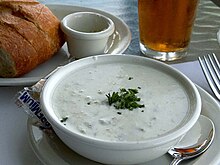Chowder

Chowder is any of a variety of soups, enriched with salt pork fatback and thickened with flour, or more traditionally with crushed ship biscuit or saltine crackers, and milk. To some Americans, it means clam chowder, made with cream or milk in most places, or with tomato as "Manhattan clam chowder." Corn chowder is a thick soup filled with whole corn (maize) kernels. The most accepted etymology for the word chowder comes from the pot in which it is cooked. The French word chaudière translated means "a pot," developed from chaud, "hot" (also related to the Latin Calderia and English Cauldron). The word "chowder" is a New England word that came from Newfoundland, where Breton fishermen — who would throw portions of the day's catch and other available foods into a large pot — introduced the word, and perhaps the fish soup itself (compare bouillabaisse). Another possible origin for the word Chowder is derived from the Old English "jowter", which means fishmonger (one who peddles fish).
Fish chowder, along with corn and clam chowder, continues to enjoy popularity in New England. Seafood chowder is a traditional and popular dish in Ireland.
Chowder competitions
Newport, Rhode Island's Great Chowder Cook-Off, held each year since 1981, is the world's largest and oldest chowder competition.[1] The 2003 event was featured in a Food Network documentary.[2][3]
Southern Illinois Chowder
The meaning of chowder in Southern Illinois is completely different from that of the New England meaning of chowder. In Edwards County, Illinois, the term "chowder" is of French-Indian origin and means not only the actual chowder which is eaten, but also the social gathering at which it is made and eaten.. It is very popular in the southern part of the United States and is believed to have been brought to this area by the earliest settlers, or "backwoodsmen'. Traditionally, "chowder time" starts when the tomatoes ripen and closes with the first heavy frost.
Chowder is usually cooked outside in large black kettles or cauldrons, ranging in size from 20 to 70 gallons. The various ingredients used in making chowder are added to the boiling water, according to their time for cooking, so that all of the ingredients are done at the same time. Chowder is usually done when the ingredients have cooked up into a fairly thick soup usually four or more hours. The kettles must be stirred almost continuously while cooking so that the chowder does not scorch. The stirring is accomplished with the use of a wooden blade from eighteen to twenty-four inches long and six to eight inches wide that has several holes bored in it. To the bade is attached a handle at right angles near the end of it. The stirring device is commonly referred as a "paddle".
In 1958, the County Commissioners of Edwards County, Illinois proclaimed Edwards County, Illinois as the "Chowder Capital of the World".
References to chowder in popular culture
- As Springfield Meatloaf, in at least one episode of The Simpsons. The pronunciation of the word "chowder" (properly pronounced in a Boston accent as "chowdah") also served as an important plot element in another episode, The Boy Who Knew Too Much. In another Simpsons episode, Homer while praying to God thanks God "for giving us two kinds of Clam Chowder".
- In the song, c. 1898 by George L. Giefer "Who Threw the Overalls in Mistress Murphy's Chowder," which survives primarily (slightly corrupted) as a repeated children's chant "Who put the overalls in Mrs. Murphy's chowder?/Nobody answered so we asked a little louder." Lyrics at [4], [5], [6], tune at [7], 1901 audio recording at [8].
- In the slang word "chowderhead." Wentworth and Flexner: "A stupid person; one who uses poor judgment. Since c. 1835." (One of many expressions analogizing a head to a soft, mushy substance).
- In the long-running comic strip Calvin and Hobbes, the term "chowderhead" is used several times by the main characters, often in the pair's arguments.
- Chowder appears in Chapter 15 of "Moby-Dick". Clam and cod chowder are served to Ishmael and Qeequeg in Hosea Hussey's Try Pots Inn at Nantucket the evening before Ishmael sets foot on the Pequod for the first time.[9]
- In Fight Club Marla Singer orders the clam chowder. Knowing that many of the members 'pollute' the food, the narrator asks the waiter for "clean food please", to which the reply is "In that case sir may I advise against the lady having the clam chowder."
- The main character named Chowder is from the new Cartoon Network show Chowder. see Chowder (TV series)
- Boston blogger and broadcaster (and—fill-in for Hugh Hewitt) Dean Barnett is known as "chowdah" for his thick regional accent
see Wikipedia entry for Dean Barnett [10] [11]
References
- Wentworth, Harold and Stuart Berg Flexner, 1967, Dictionary of American Slang, Thomas Y. Crowell, NY. ISBN 0-690-23602-6 ("Chowderhead" definition, in use since c. 1835).
- Robert's Guide To Eating Chowder
- Edwards County Historical Historical Society, Albion, Illinois, A History of Edwards County, Illinois Volume One 1980
